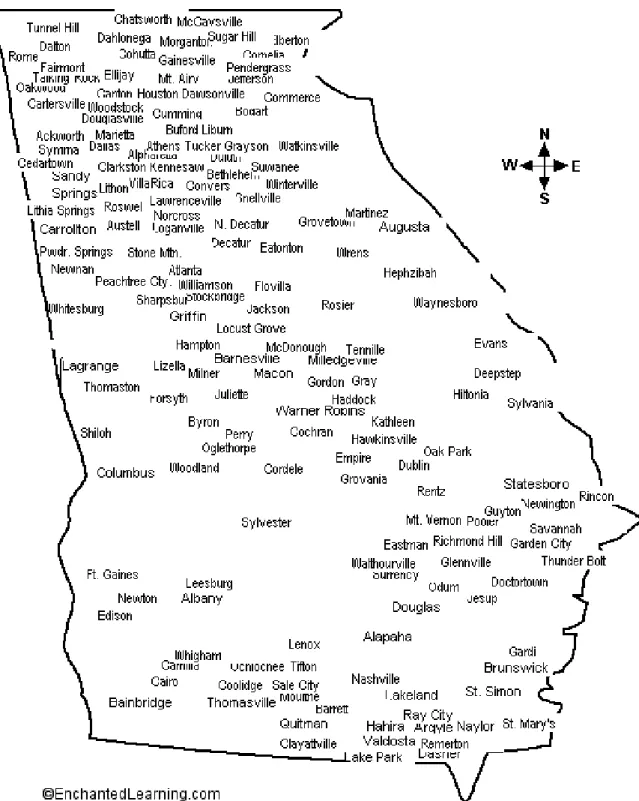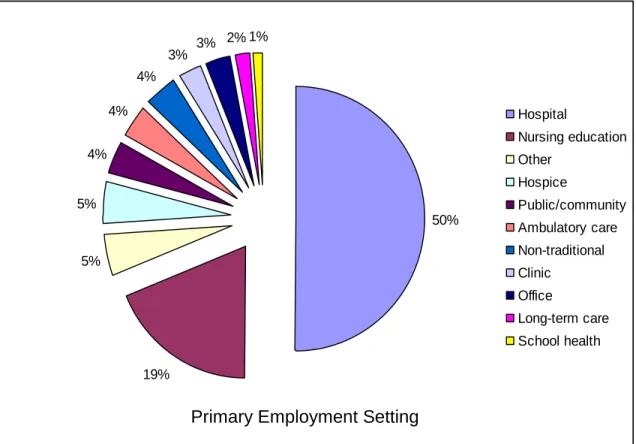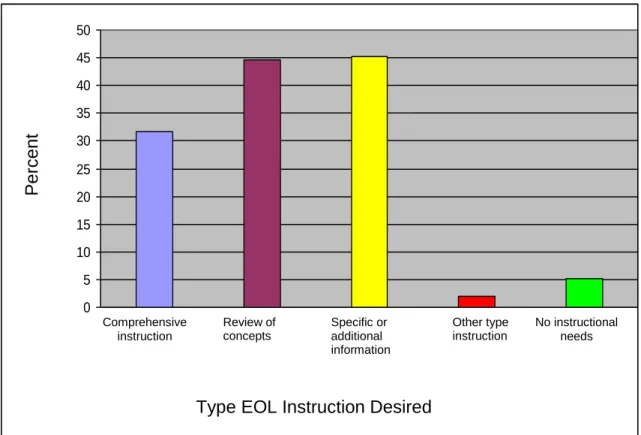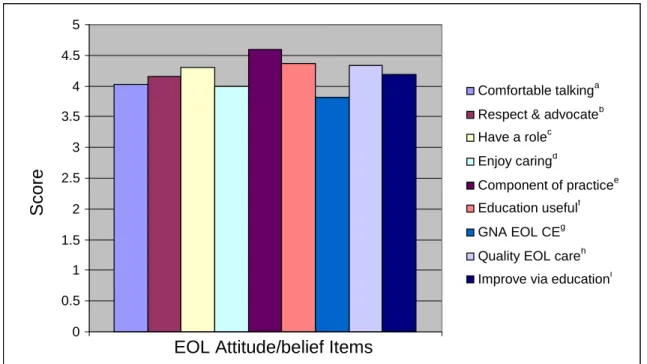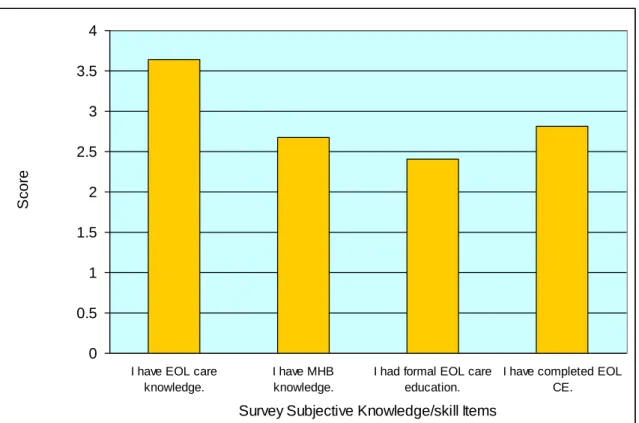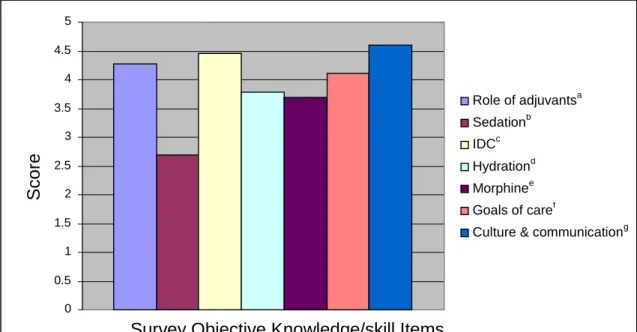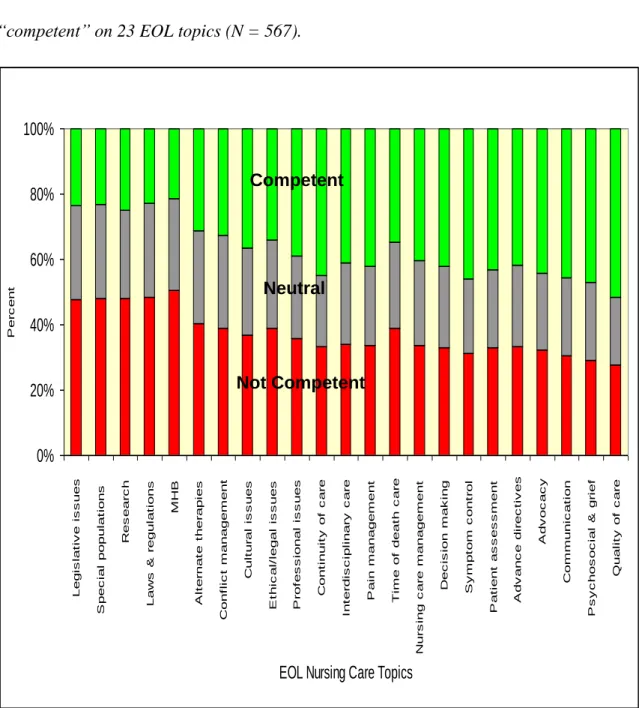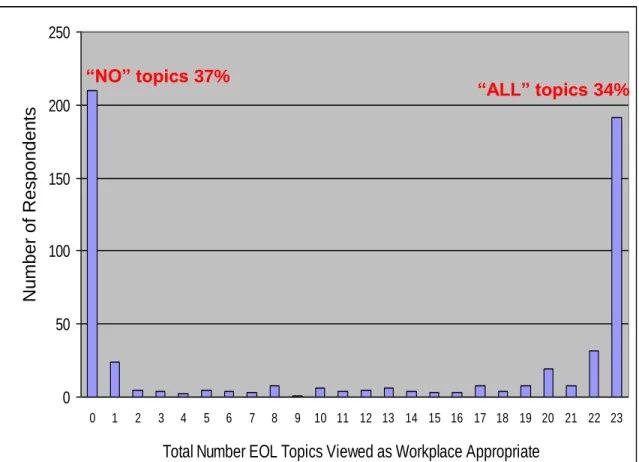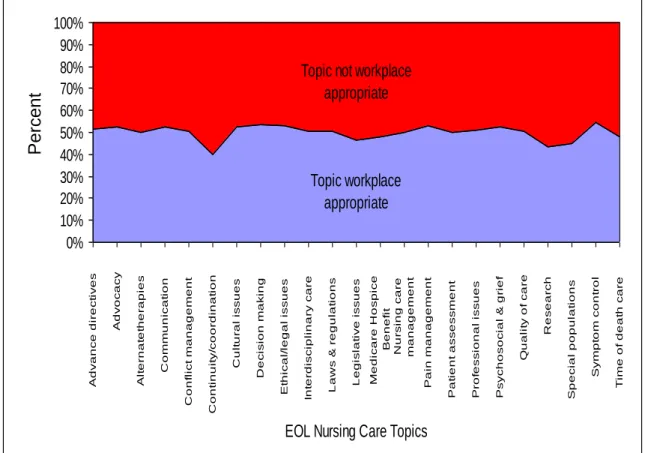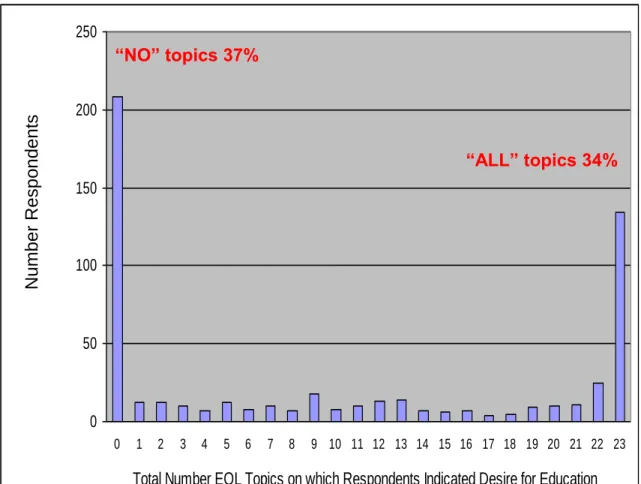Survey of Nurses’ Educational Needs Related to End of Life Care
A Dissertation submitted to the Graduate School Valdosta State University
in partial fulfillment of requirements for the degree of
DOCTOR OF EDUCATION
in Curriculum and Instruction
in the Department of Curriculum and Instructional Technology of the College of Education
May 2006
Maura C. Schlairet
MSN, Valdosta State University, 1997 BSN, Valdosta State University, 1995
©Copyright 2006 Maura C. Schlairet All Rights Reserved
Fair Use
This dissertation is protected by the copyright Laws of the United States (Public Law 94-553, revised in 1976). Consistent with fair use as defined in the Copyright Laws, brief quotations from this material are allowed with proper acknowledgements. Use of the material for financial gain without the author’s expressed written permission is not allowed.
Duplication
I authorize the Head of Interlibrary Loan or the Head of Archives at the Odum Library at Valdosta State University to arrange for duplication of this dissertation for educational or scholarly purposes when so requested by a library user. The duplication shall be at the user’s expense.
This dissertation, “Survey of Nurses’ Educational Needs Related to End of Life Care”, by Maura C. Schlairet, is approved by:
Dissertation Committee
Chair _______________________________________
Mark J. Fenster, Ph.D.
Assistant Professor of Educational Leadership
Committee Member _______________________________________ Chet Ballard, Ph.D.
Professor and Head of Sociology, Anthropology, and Criminal Justice
_______________________________________ Ellen W. Wiley, Ed.D.
Professor of Curriculum and Instructional Technology
_______________________________________ Susan J. Wold, Ph.D., RN
Professor of Nursing
Dean of the College
of Education _______________________________________
Philip L. Gunter, Ph.D.
Professor of Special Education and Communication Disorders
Dean of the
Graduate School _______________________________
Brian U. Adler, Ph.D. Professor of English
ABSTRACT
A decade after release of the landmark Study to Understand Prognoses and Preferences for Outcomes and Risks of Treatment, improvements in end of life (EOL) care are
apparent. Notwithstanding an improved dialogue focused on EOL care, evidence suggests persistent shortcomings in our ability to meet the needs of the dying. Registered Nurses must possess the knowledge/skill to assist patients/families in managing health across all stages of life, including the EOL phase. A significant proportion of practicing nurses have not received formal EOL care education. Of further concern, deficiencies in existing formal EOL care education have been well described. Insufficient information exists on specific EOL care educational needs of practicing RNs. Few surveys exploring
educational needs of nurse generalists have been available and no large-scale utilization of any one instrument has been identified. To aid in development of EOL continuing education (CE) for RNs, a survey was designed to explore nurses’ EOL care
attitude/belief, knowledge/skill, education, and learner characteristics. The survey was published in a state nurse association newspaper and mailed to all RNs in one
southeastern state. A Web-based version of the survey was also available. The accessible population consisted of 51,000 licensed RNs. Return of 567 surveys, primarily via the Web, resulted in a response rate of 1.1%. Reliability was assessed with calculation of coefficient alpha of 0.96 across survey sections. The majority of respondents had neither formal EOL education nor prior EOL CE. Yet, nurses held positive attitude/belief toward EOL care and the majority desired EOL CE. T-tests revealed nurses with prior EOL CE scored significantly better than nurses without CE across all survey subsection; nurses who received formal EOL instruction during initial nursing education failed to score
better on objective EOL knowledge/skill questions than nurses without formal EOL education. MANOVAs identified a similar counterintuitive pattern. Bimodal distributions were observed in analyses of “workplace appropriateness” and “desire for education” scores across 23 EOL care topics. Chi-square analyses revealed significant contributions of EOL attitude/belief, prior EOL CE, and objective EOL knowledge/skill toward positive views on EOL workplace appropriateness and desire for EOL education.
TABLE OF CONTENTS I. INTRODUCTION………..1 Overview………...………..……….1 Aims……….…6 Goals ………..….8 Justification ……….………9 Definition of Terms……….…………...12 Theory………...……15 Induction………15 Paradigm………16 Typology………17 Exploration……….17 Description……….17 Survey………18 Learning Styles………..18 Competency Assessment………...…19 Joint Construct………...19 Assessment Framework……….20 Common Meaning……….20 Previous Research………..…………....……21 Availability of Data……….……...23 Limitations……….23
II. LITERATURE REVIEW……….………24
Registered Nurses………..…24
Population………..…24
Nurses and Research………..…27
The State of End of Life Care………31
A National End of Life Perspective……….…..31
The Georgia End of Life Perspective………...……..43
Attitudes Toward End of Life Care……….………….…….46
The State of End of Life Care Nursing Education……….…………..…..49
A National Educational Perspective………..49
The Georgia Educational Perspective………52
Essential End of Life Education………..…..…53
Existing End of Life Educational Initiatives………..…59
The Influence of Education on Attitudes Toward End of Life Care……..63
Studies of Nurses’ Educational Needs Related to End of Life Care…………..…65
Surveys with Healthcare Professionals and Others………...…65
Surveys with End of Life Nurse Specialists………..66
Surveys with Nurse Generalists……….……69
Surveys with Nurse Generalists in the Region………..73
The Role of Professional Organizations in End of Life Education…………...…74
Continuing Education for Nurses………..……77
Educational Needs Assessment………..……82
III. METHODOLOGY………...…97 Participants………..….….99 Instrument………100 Survey Instrument………....100 Reliability of Constructs……….……….105 Validity………106 Pilot Testing………...108 Procedure……….……108 Data Analysis………...…111 Study Limitations………..………...…111 IV. RESULTS………...………115
Interval Level Statistics and Ordinal Data……….…..115
Demographic Information………115
Nurses in Georgia………115
Nurse Learner Characteristics………..……121
Nurse Association Member Characteristics……….……130
Univariate Analysis………..…136
Bivariate Analysis………155
Nurses’ End of Life Attitude/belief……….……155
Nurses’ End of Life Knowledge/skill………..160
Nurses and End of Life Continuing Education ………...……168
Nurses and Formal End of Life Education……….…….169
Null hypothesis I………..…170
Null hypothesis II……….…174
Chi-square Test of Independence: Workplace Appropriateness and Education Desire………..…………177
Multivariate Analysis………...………186
Multiple Linear Regression: Formal Education and Continuing Education……….186
MANOVA and Differences in Scores: Formal Education and Continuing Education……….……193
Nurses’ Views and Challenges of End of Life Care...199
Results Summary……….…203
Univariate and Demographics………..………203
Bivariate………...…205
Multivariate………..……207
Supplemental Research Strategies………..….208
V. Discussion, Implications, and Recommendations………..210
Discussion………210
Overview……….……….210
Are Educational Initiatives Working?...212
End of life care and nurses’ knowledge/skill………...212
End of life care and nurses’ attitude/belief………..215
Influence of formal EOL education……….216
End of life workplace appropriateness and education desire…...222
Nurses’ Views and Challenges of End of Life Care………225
Response Rate………..…226
Perspectives……….…….226
Nurses and research……….……228
Web survey format……….….229
Generalizability of Findings………229
Selection bias concern……….….229
Nurse characteristics: State and national level comparison…….230
Nurse association membership characteristics………...233
Self-assessment Concerns………234
Validity issues………..234
Novice to expert scale……….….235
Subjective and Objective Knowledge/skill………..……237
How nurses know……….…237
Realistic knowledge appraisal………..…239
Educational Needs Assessment………...….239
Learner characteristics……….239
Identification of nurse attitude-related needs……….…..240
Professional Association and end of life continuing education development……….241
Instrument Utility……….241
Education………...243 Practice……….244 Theory………..245 Research………..….246 Recommendations………...…….246 Research……….………..247 Education……….248 Conclusion………..……….249
VI. REFERENCE LIST………..……….………….………250
VII. APPENDICES………291
Appendix A: Letter of Intent………..……..……291
Appendix B: Association Permission Letter………...….293
Appendix C: Valdosta State University IRB Approval Letters………….…..…295
Appendix D: Existing Surveys Reviewed for Association Project………..298
Appendix E: End of Life Care—Educational Needs Survey………...…301
LIST OF FIGURES
1. Georgia Cities and Towns Listed by Respondents as Their Primary
Residence……….…117 2. Respondent Primary Employment Setting (N = 552)………..120 3. Percent of Respondents Selecting Desired EOL Instruction by Type (N =
567)……….….122 4. Mean Scores on Nine EOL Attitude/belief Survey Items (N = 565)………...…138 5. Mean Scores on Four EOL Subjective Knowledge/skills Survey Items (N =
563)………..140 6. Mean Scores on Seven EOL Objective Knowledge/skills Survey Items (N =
565)………..141 7. Percent Respondents Rating Themselves “Not Competent”, “Neutral” or
“Competent” on 23 EOL Topics (N = 567)……….………146 8. Percent of Respondents Indicating “None” or “All” EOL Topics as Workplace
Appropriate (N = 567)………...………..151 9. Percent of Nurse Respondents Indicating Specific EOL Care Topics as “Work
Appropriate” or “Not Work Appropriate” (N = 567)…………..………152 10.Respondents Desiring Education on “None” or “All” EOL Topics (N =
LIST OF TABLES
1. Ethnicity of Sample by Sub-group (N = 554)………..………116
2. Respondent Community Population Size Classification (N =556)……….118
3. Respondent Highest Degree Earned in Any Field (N = 557)………..119
4. Respondent Preferred Learning Format(s) by Percent (N = 567)………123
5. Respondent Purpose(s) or Goal(s) for Seeking EOL Education by Percent (N = 567)……….….125
6. Percent Respondents Selecting Situational Barriers to EOL Care Professional Education (N = 567)………127
7. Percent Respondents Selecting Learning Program Barriers to EOL Care Professional Education (N = 567)………...……….128
8. Percent Respondents Selecting Learner-derived Barriers to EOL Care Professional Education (N = 567)………..……..129
9. Comparison of Respondent Gender, Age, Ethnicity, and Community Size by GNA Membership Status (N = 554)………131
10.Comparison of Respondent Current Professional Status and Percent EOL Patient Care Involvement by GNA Membership Status (N = 554)……….132
11.Comparison of Respondent Initial Degree, Average Number Years Since Earning Initial Degree, and Highest Degree by GNA Membership Status (N = 554)…..133
12.Chi-square Analysis of Group Differences Associated With Active GNA Membership Status………..….134
13.Independent Samples T-tests of Mean Differences Associated With Active GNA Membership Status………...135
14.Section A Mean Scores for Attitude/belief Items, Subjective Knowledge/skill Items, and Objective Knowledge/skill Items………...137 15.Respondent Mean Scores (1 – 5) on Overall Self-rated Competence for EOL
Nursing Care………....142 16.Respondent EOL Knowledge/skill Competency Scores (1 – 5) for 23 EOL
Content Areas………...144 17.Percent Respondents Viewing EOL Topics as “Non-workplace Appropriate” (N =
567)………..148 18.Percent Respondents Indicating “No Desire” for Individual EOL Care Topic
Education……….149 19.Pearson Product Moment Correlations for Attitude/belief Section Total With
Other Survey Section Totals (N = 567)………...156 20.Pearson Product Moment Correlations for Attitude/belief Item Scores and
Subjective and Objective Knowledge/skill Item Scores on Survey Section A (N = 567)………..159 21.Pearson Product Moment Correlations for EOL Knowledge/skill Sub-section
Scores (N = 576)………..161 22.Pearson Product Moment Correlations for “Prior EOL CEU” and “Prior Formal
EOL Education During Initial Nursing Program” With Objective Knowledge/skill Item Scores in Survey Section A (N = 567)………....163
23.Pearson Product Moment Correlations for Objective Knowledge/skill Item Scores in Survey Section A Amongst Respondents Who Stated They Possessed Adequate EOL Nursing Care Knowledge Compared to Those Who Stated They Lacked Adequate EOL Nursing Care Knowledge (N = 567)………...165 24.Pearson Product Moment Correlations for “Work Appropriateness” and “Desire
for Education” With EOL Knowledge/skill Section Sub-totals in Survey Section A and C (N = 567)………...167 25.Means Comparison Using T-tests of Survey Attitude/belief, Overall Skill, and
Overall Knowledge Scores for Nurses With and Without Formal EOL Education During Initial Nursing Education……….172 26.Means Comparison Using T-tests of Survey Objective Knowledge/skill,
Subjective Knowledge/skill, Workplace Appropriateness, and Desire for Education Scores for Nurses With and Without Formal EOL Education During Initial Nursing Education……….173 27.Means Comparison Using T-tests of Survey Attitude/belief, Overall Skill, and
Overall Knowledge Scores for Nurses With and Without EOL CE During the Prior Five Years………...175 28.Means Comparison Using T-tests of Survey Objective Knowledge/skill,
Subjective Knowledge/skill, Workplace Appropriateness, and Desire for Education Scores for Nurses With and Without EOL CE During the Prior Five Years………176
29.Chi-square Test of Independence for Nurses’ Workplace Appropriateness Score Across 23 EOL Topics by Formal EOL Education, Prior EOL CE, Attitude/belief Score, and Objective Knowledge/skill Score………...178 30.Crosstabs Cell Display for Nurses’ Workplace Appropriateness Score by Status
on Prior EOL CE………..179 31.Crosstabs Cell Display for Nurses’ Workplace Appropriateness Score by
Attitude/belief Score………....180 32.Crosstabs Cell Display for nurses’ Workplace Appropriateness Score by
Objective Knowledge/skill Score………...….181 33.Chi-square Test of Independence for Nurses’ EOL Education Desire Score Across
23 EOL Topics by Formal EOL Education, Prior EOL CE, Attitude/belief Score, and Objective Knowledge/skill Score……….….182 34.Crosstabs Cell Display for Nurses’ EOL Education Desire Score by
Attitude/belief Score………184 35.Crosstabs Cell Display for Nurses’ EOL Education Desire Score by Objective
Knowledge/skill Score……….185 36.Regression Coefficients for Calculating the Predicted Overall EOL Skill and
Overall EOL Knowledge Self-ratings Based on Formal EOL Education and Prior EOL CE………....188 37.Regression Coefficients for Calculating the Predicted Attitude/belief Score Based
38.Regression Coefficients for Calculating Predicted Objective Knowledge/skill Score, Subjective Knowledge/skill Score, and Knowledge/skill Competency Rating Across 23 EOL Topics, Based on Formal EOL Education and Prior EOL CE………....192 39.Dependent Variable Mean and Adjusted Mean with Confidence Interval by
Participation in Formal EOL Education During Initial Nursing Education…....196 40.Dependent Variable Mean and Adjusted Mean With Confidence Interval by
Participation in Prior EOL CE……….197 41.Nurses’ Views and Challenges of EOL Care: Respondent Comments Classified as “EOL Topic-related”………....200 42.Nurses’ Views and Challenges of EOL Care: Respondent Comments Classified as “Societal EOL Issues”………..202 43.Comparison of Characteristics Between Georgia RN Survey Respondents (N =
ACKNOWLEDGMENTS
I would like to acknowledge the following individuals for their assistance and support with this research:
Dr. Chet Ballard, Dr. Ellen Wiley, and Dr. Susan Wold for serving on my Committee and providing insight, thoughtful review, valuable feedback, and encouragement with this research.
Dr. Carol Sapp, Ms. Cindy Balkstra, and other officers and executives of the Georgia Nurses Association who allowed me to partner with them in their tireless professional efforts to serve the RNs of the state and the patients they care for. The state’s RNs are fortunate to have leaders of such caliber.
Mr. Mark Swift who graciously programmed my End of Life Care—Education Needs Survey into an Active Server Page, thus making the survey available on the World Wide Web and allowing Web-based data collection and data base archiving.
My Chair, Dr. Mark Fenster, for his unparalleled expertise and contagious enthusiasm for research. With an ability to ignite a spirit of inquiry, considerable skill in teaching the demanding research domain, and willingness to share his time, he provided exemplary modeling of the scholarship and service components of the faculty role. Fenster, well done; just as I expected!
My husband, Dr. Timothy J. Schlairet, for his unwavering support, encouragement, and personal sacrifice that allowed me to fulfill this professional goal. No one could have done more! If not for Taylor, Brooke, and T.J., who were uncomplaining and
understanding kids through this all-encompassing process, I might have forgotten that the world continued to turn while I was working on my dissertation!
DEDICATION
CHAPTER I Introduction
Significant concern exists amongst policy agents, healthcare professionals, researchers, and the general public over the present state of end of life (EOL) care across the nation. In part, these concerns have resulted from a changed profile of Americans, changes in how people die (Ferrell, 1999), and reported deficiencies in existing care for the dying.
Recognizing that registered nurses (RNs) spend more time with the dying than any other healthcare professional (Baggs, 1993; Murray-Frommelt, 1991; Fakhoury, 1998), it is not surprising that inquiry about issues of EOL care delivery focus largely on the contribution of nursing care in the overall provision of exemplary EOL care. To gain an accurate understanding of essential attitudes, knowledge, skill, and core competencies nurses must possess to promote excellence in the delivery of EOL nursing care, there must also be a general understanding of nurses and needs assessment, nursing education and continuing education, professional organizations and professional development, and a detailed description of the existing state of EOL care in America.
Overview
A dramatic increase in the percentage of elderly Americans (Federal Interagency Forum on Aging-related Statistics, 2004; Field & Cassel, 1997) has contributed to significant changes in society. Rushton, Sabatier, and Gaines (2003) observed improvements in nutrition, sanitation, cardiopulmonary resuscitation, and disease
detection and treatment, along with the development of vaccinations, antibiotics, preventive medicine, and technological advances have contributed significantly to increased longevity. The appearance of dying in America has been changing as well— from one of acute, often infectious processes and a rapidly ensuing demise, to that of chronic, incurable, progressive illness that eventually culminates in organ failure and death (Teno, McNiff, & Lynn, 2001). Steinhauser, Clipp et al. (2000) observed the changing trends associated with these processes has resulted in a dramatic shift in the culture of death in the 20th century—a shift that has profound implications for EOL care.
Although Field and Cassel (1997) argue for the ―compression of morbidity hypothesis‖—improvements in nutrition, diagnosis of disease, and preventive medicine resulting in people experiencing disabling conditions for a smaller percentage of the years before death—the absolute number of dying patients in America will grow significantly over the next few decades (p. 261). The population of seniors in the United States is projected to double over the next 30 years, rising to 69 million by 2030. Of the nation‘s baby boomers, one in nine is expected to live to age 90; in 2040 there will be four times the number of people over the age of 85 as there were in 2003 (Jennings, Ryndes, D‘Onofrio, & Baily, 2003). National data from 2002 suggested that almost 10% of Georgia residents were age 65 or over (Federal Interagency Forum of Aging-Related Statistics, 2004).
Other changes in the patient population and the healthcare system have
contributed to evolving concerns about EOL care. The increasing incidence of chronic diseases, a shortfall of caregivers (Last Acts National Coalition, 2002; Oncology Nursing Society, 2002; Reb, 2003), a limit in cancer care resources, heightened acuity amongst
greater numbers of frail patients with increased comorbidity and disability, increased family mobility and isolation (Rudberg, Teno, & Lynn, 1997), and an escalation of healthcare costs (Picket, Cooley, & Gordon, 1998) conspire to negatively affect the provision of expert, compassionate EOL care. In fact, some view national legislation on euthanasia and assisted suicide as evidence of a society-wide dissatisfaction and angst associated with EOL care as it is currently being delivered in America (Ferrell, 1999).
Dying has been described as a biologic process as well as a social and
psychological experience that unfolds within a particular cultural milieu, and it has been suggested that, ―Dying is far harder than it should be‖ (Field & Cassel, 1997, p. 259). According to Teno et al. (2001), the types of needs created for the dying by such a complex phenomenon are too important to ignore; preliminary recommendations for accountability in EOL care are warranted. A senior communications officer of the Robert Wood Johnson Foundation (RWJF), commenting on people‘s perceptions of ―bad deaths‖ as experienced by their loved ones, noted, ―Everyone interprets the (bad) experience as a totally idiosyncratic confluence of disease, personality, doctor, and so on. They don‘t see it as reflecting systemic issues. But it is‖ (Bronner, 2003, p. 4). This type of thinking often results from a fundamental lack of information on the EOL phase of life and a misunderstanding of tenets of EOL care.
In a discussion of both the public‘s and health care professionals‘ ignorance of EOL educational initiatives funded by the RWJF, experts observed the notion of a good death has salience only after a loved one has died—most people don‘t want a good death they want a cure (Weisfeld, Miller, Gibson, & Schroeder, 2000). Society‘s ambivalence about dying has, ―led to a system of care for the terminally ill that allows us to indulge
the fantasy that dying is somehow optional‖ so that we now have a, ―medical system for the dying that is as ambivalent about dying as we are ourselves‖ (Henig, 2005, p. A4).
Considerable efforts have begun to address some of the shortfalls observed in EOL care. In fact, most clinicians and policy agents view the provision of EOL services as a moral imperative. For example, the American Geriatrics Society (1995) observed EOL patients must have access to interdisciplinary EOL care (IDC) across the spectrum of care settings—not limited only to traditional EOL care settings like oncology units and hospices.
Some believe EOL care in the US has arrived at a point where assessment of quality and determinations of accountability have come to the fore. Jennings et al. (2003) observed, ―For our moral identity is nowhere better tested and tempered than in the respect and care we show to those in the twilight of life‖ (p. S13). Fortunately, the importance of research and the development of a strong evidence base to support EOL care have been recognized (Hughes & Addington-Hall, 2005) and represent an important component of modern EOL care (Jubb, 2002; Saunders, 2003). In fact, since 1997, considerable attention in the form of research initiatives has been focused on improving EOL care in the U.S., to include collaboration amongst agencies within the U.S.
Department of Health and Human Services such as the National Institute of Nursing Research and the National Institutes of Health (Knebel, 2004).
As a profession, and at all levels, nursing has begun to address critical needs associated with EOL care. It has been observed that nurses spend more time with the dying than any other healthcare professional (Baggs, 1993; Murray-Frommelt, 1991; Fakhoury, 1998). Rushton et al. (2003) viewed EOL care as a core competency for all
RNs. A 1997 Institute of Medicine report on EOL care observed, ―Nurses are expected to have sufficient knowledge to care for patients during all life stages, including dying‖ (Field & Cassel, 1997, p. 228) and practitioners must hold themselves and their colleagues responsible for meeting the complex needs of the dying. Simmonds (1996) provided evidence of this notion, finding that nurses believed that it was their
responsibility to assure patients experienced calm, pain-free, peaceful deaths. Thompson, Cullum, McCaughan, Sheldon, and Raynor (2004) corroborated this view of
responsibility from other perspectives noting, ―Nurses are increasingly regarded as key decision makers within the healthcare team. They are also expected to use the best available evidence in their judgments and decisions‖ (p. 72).
In the Report of the Special Subcommittee on the Management of Acute and Terminal Pain (Joint Committee on Health Care, 1997) it was noted that at the core of the clinicians‘ professional commitment, rests the ethical obligation to relieve patients‘ suffering. The Code of Ethics for Nurses operationalized this duty stating, ―Nurses are required to have knowledge relevant to the current scope of nursing practice, changing issues, concerns, controversies, and ethics‖ (American Nurses Association [ANA], 2001, p. 24). Nurses play an important role in EOL care since RNs are the key to quality and capacity in EOL care as the roles filled by nurses run the entire spectrum of the health care system and nurses perform essential functions throughout all aspects of patient care (Health Care Workforce Policy Advisory Committee, 2003).
In 1997 the International Council of Nurses drafted a mandate stating, ―Nurses have a unique and primary responsibility for ensuring that individuals at the EOL experience a peaceful death‖ (Ferrell, 1999, p. 33). Field and Cassel (1997) advanced a
reasonable call for, ―basic grounding‖ (p. 269) in EOL care for all clinicians who deal directly with patients and families. Sadly, in a 2004 statement emerging from the
National Institutes of Health (NIH), it was noted, ―Little evidence was provided regarding the experiences of professional caregivers at the EOL‖ (NIH, 2004, p. 13). Clearly, despite nurses‘ strong sense of professional responsibility in the delivery of exemplary care for the dying, comprehensively addressing systemic EOL care issues (Bronner, 2003) extends well beyond the level of the individual nurse.
In view of such findings, this research effort, to better identify the specific EOL care educational needs of nurse generalists utilizing a cross-sectional survey, represents the logical next step that might add meaningfully to the state-level and national dialogue focused on improving EOL care for all.
Aims
To better identify the specific EOL nursing care learning needs of practicing nurses, the primary aim of this study was the development of a data-driven, descriptive analysis of the educational needs of Georgia‘s nurses related to provision of care for the dying. This analysis, based on a survey research approach, was conducted to support the Georgia Nurses Association‘s (GNA) comprehensive understanding of the needs of the state‘s nurses in relation to ongoing professional development. It was hoped that this tacit understanding would allow the GNA to design targeted continuing education initiatives to improve the provision of EOL care across the state. The Institute of Medicine, in the most recent report on dying, called explicitly for surveys of health care providers on EOL care from these professionals‘ perspectives (Lunney, Foley, Smith, & Gelband, 2003). In a 2004 report on key indicators of well-being amongst older Americans, the Federal
Interagency Forum on Aging called specifically for additional state-level data related to the health and healthcare needs of older populations to promote accurate assessment and planning for the requirements of the aging populous (Federal Interagency Forum on Aging-Related Statistics, 2004).
From a wider perspective, as described by Rudestam and Newton (1992), an additional aim of this study was to contribute to the existing body of scholarly work devoted to the identification of educational needs amongst practicing nurses in relation to the provision of EOL care. Although surveys exploring these needs have been developed, to date no comprehensive instrument exploring EOL care needs amongst nurse
generalists has been developed or widely implemented in the United States or the United Kingdom. Few instruments have simultaneously addressed EOL attitudes/beliefs,
subjective and objective knowledge/skills, learning styles and preferences, workplace relevancy of EOL care, workplace support for continuing education, learner goals and educational barriers, knowledge/skill self-ratings across EOL topical areas, desire for specific EOL education across topical areas, an array of demographic data, and ―open-ended‖ responses about specific topics they deemed necessary for the provision of EOL care. Describing the potential challenges of dealing with data related to EOL patients and care issues, the authors of a 2003 Institute of Medicine report on dying in America noted, ―Clearly, some early pilot studies will have to use tools that are not validated, but one aim of that type of research will be to learn about the tools and determine whether they can be used widely‖ (Lunney et al., 2003, p. 54).
Goals
One goal of this study was to assess the EOL attitudes/beliefs, EOL
knowledge/skills, and prior EOL education/training of nurses in Georgia. Although the literature suggested that aspects of EOL nursing care had been evaluated (Field & Cassel, 1997; Foley & Gelband, 2001; Last Acts National Coalition, 2002; NIH, 2004;
SUPPORT Principal Investigators, 1995) and nursing curricula and specific educational initiatives had been developed to address nurses‘ apparent EOL care deficits (American Association of Colleges of Nursing [AACN], 2002; Bronner, 2003; Rushton & Sabatier, 2001), little is known about the specific EOL care knowledge, skills, and prior EOL education of nurse generalists‘ currently in practice.
A second goal was to describe nurse generalists‘ learning characteristics and preferences. The literature suggested that a variety of barriers affected learning related to EOL care (Ferrell, 1999; Kirchhoff & Beckstrand, 2000; Rooda, Clements, & Jordan, 1999) and these must be identified and managed. Additionally, learning theory, as it pertains to adult learners, has suggested that the unique goals and desires of adult learners influence their learning outcomes and should thus be utilized to best shape educational offerings and opportunities (Bowden & Merritt, 1995; Brookfield, 1984; Burns, 1995; Cranton, 2000; Rogers, 2002; Van Tilburg & Moore, 1989).
A third goal was to identify nurses‘ EOL educational needs. Although a general call for improvements in EOL care education has been sounded (Bradley et al., 2001; Ferrell, 1999; Field & Cassel, 1997; Hilden et al., 2003; Kazanowski, 1997; Meier, Morrison, & Cassel, 1997; McPhee, Rabow, Pantilat, Markowitz, & Winder, 2000; Reb, 2003) the specific educational needs of nurse generalists have not been clearly delineated.
No existing comprehensive instruments exploring EOL care educational needs could be identified. Few large-scale (e.g., state-wide) surveys of nurse generalists‘ educational needs could be located, and those few studies identified suffered from low response rates (Brown & Timms, 2004; Marra, 1999).
A fourth goal was to examine potential relationships between nurses‘
characteristics, educational needs, and EOL attitudes/beliefs/knowledge/skills. It has been suggested that EOL care education presents unique challenges for both students and educators alike (Sweeney & Bruera, 2001). A complex array of variables contributes to an individual‘s ability to honestly and accurately self-assess clinical knowledge and skills—especially in emotionally laden situations (e.g., death and dying) that often present themselves as clinical crisis events. Hypothesis testing was used to explore relationships between nurses‘ participation status on prior EOL care education (i.e., formal EOL education during initial nursing education or EOL care continuing education) and EOL care attitude/belief along with knowledge/skill.
Additionally, the researcher sought to determine the utility of a survey instrument, the End of Life Care—Educational Needs Survey, for the purpose of identifying EOL care educational needs amongst nurse generalists in other settings. Information on reliability of measurement and validity of resultant inferences was sought to better understand the potential value of additional survey development efforts and ongoing utilization of the instrument.
Justification
Justification forthis study was grounded in the belief that for those who are dying, a profound and universal experience, the goal of a experiencing a good death—as
free as humanly possible from pain and suffering, aligned with personal values and desires, and rational in consideration of ethical standards and social resources—must be possible (Jennings et al., 2003; Lunney et al., 2003). ―If dying includes everyone within its ambit, our society‘s care giving response to dying should be no less inclusive‖ (Jennings et al., p. 44).
EOL care is clearly a part of the most basic healthcare services, standing perhaps as a moral imperative (Jennings et al., 2003), yet far too many people traverse the end of life phase and approach death without adequate medical, nursing, social, and spiritual support. These unmet needs may render the dying unable to finish the ―existential tasks‖ aligned with the affective dimensions of dying (Jennings, 1997, p. 120). Dying badly is a social problem—a failure at the social level to adequately attend to and provide for the needs of patients in their most vulnerable moments (Jennings et al.). Kathleen Foley, the Director of the Project on Death in America and co-editor of the 2001 Institute of
Medicine report on EOL care observed, ―There are no villains in this piece but ourselves and our culture. Public institutions and policymakers reflect dominant societal values that still deny dying and death‖ (Foley & Gelband, 2001, p. 10).
Jennings et al. (2003) describe dying as, ―The ultimate private event, but it is also a profound social event; the community is automatically and inherently involved‖ (p. S13). Sulmasy (2003) noted the processes inherent in the provision of compassionate EOL care result in ―rebound‖ that contributes substantially to the common good—all are benefited when the dying are well cared for. He goes on to posit we owe all members of society, out of respect for our common dignity, the gift of a reasonably good death (Sulmasy).
McPhee, Rabow, Patilat, Markowitz, and Winker (2000) noted, ―One of the greatest gifts in confronting death is the perspective it offers about living life‖ (p. 2513). Along with Sulmasy‘s (2003) notions of the common good, Pierce (1999) suggested that on the individual level, moments shared with family members while tending to the needs of their dying make for lasting memories. In relation to EOL care shortfalls, from every perspective, the ―cost of forming bad impressions is totally non-recoverable‖ (p. 13).
Meleis (1997) notes the ―open system‖ feature of nursing suggests the profession, and nurses on an individual level, must at all times be aware and responsive to the needs of society. Yet, research suggests that nurses, along with other healthcare professionals, acknowledged, ―Having acted contrary to their consciences‖ in EOL care, ―mostly by providing overly burdensome treatment to the dying‖ (Solomon et al., 1993, p. 18).
Nonetheless, progress toward improved EOL care has been at the fore of the profession‘s agenda. Nursing‘s pivotal role in improving EOL care was solidified when the National Institute of Nursing Research (NINR) was selected the lead organization within the NIH for EOL research (NINR, 2002). In 2004, speaking as the director of the NINR, Patricia Grady noted that increasing the quality of EOL care remained at the heart of the Institute‘s research agenda (Kennedy, 2005). This goal was identified earlier in an Institute of Medicine report describing dying in America (Lunney et al., 2003), in which experts called for research on, ―Valid indicators of variables and constructs that are important to good EOL care‖ (p. 12).
Discussing directions for doctoral research in 2005, Sharts-Hopko observed that inquiry must be attentive to current healthcare needs and focused on effective teaching and learning in nursing to support healthcare patterns emphasizing short stays,
community-based services, and family caregivers—the hallmarks of EOL care. Looking forward to 2006, the NINR continues to target research on EOL care and identifies the provision of EOL care in rural and frontier areas as critically important (NINR, 2005). Although several challenges exist for researchers exploring EOL issues (Lunney et al., 2003; Sweeney & Bruera, 2001), inquiry focused on educational preparation for nurses takes on greater importance viewed from the perspective of a deepening nursing shortage (Sharts-Hopko). Understanding these foci and the current healthcare delivery milieu, the Institute of Medicine‘s (Lunney et al.) call for smaller, focused explorations at the local level, as compared to inquiry at the national level, becomes exceedingly clear.
Definition of Terms
Definitional clarity related to terminology associated with the dying has been lacking (Meir, 2003; NIH, 2004). The literature describing compassionate,
comprehensive healthcare associated with the final stages of life commonly utilizes terminology such as end of life care, palliative care, and hospice care. The
interchangeability of these terms in research and practice settings represents a barrier to inquiry and research focused on EOL care improvements (NIH, 2004). Generally, the key processes of EOL care include (a) identification and communication of diagnosis and prognosis, (b) the institution of goals and plans, and (c) the shaping of EOL care to these goals (Field & Cassel, 1997). In this study, the phrase end of life care will be used as an overarching descriptor for the delivery of comprehensive, comfort and support services managed by an IDC team, addressing the physical, emotional, existential, psychological, spiritual, social, financial, and legal needs of dying patients and their families (Last Acts National Coalition, 2002). These services could be accessed and/or provided within a
hospice care or palliative care framework. To provide a deeper understanding of these and other terms used in this study, the investigator provides the following definitions. Adjuvant medications Non-opioid drugs without intrinsic analgesic effect,
capable of producing analgesia in specific situations (Bruera & Kim, 2003).
Advance directives Documents that record a competent individual‘s medical treatment preferences should the individual become unable to make medical care decisions in the future. Two common types of advance directives are the durable power of attorney and the living will (Janofsky & Rovner, 1993; Suri, Egleston, Brody, & Rudberg, 1999).
Advanced beginner nurse Practitioners with marginally acceptable performance who are independent in some aspects of practice. Dryefusskill acquisition model level No. 2 (Benner, 2001; Robinson & Barberis-Ryan, 1995).
Advanced practice nurse ―The advanced practice nurse is an umbrella term given to an RN who has met advanced educational and clinical practice requirements beyond the 2 - 4 years of basic nursing education required of all RNs. Under this umbrella fall four principle types of advance practice: Nurse Practitioner, Certified Nurse Midwife, Clinical Nurse Specialist, and Certified Registered Nurse Anesthetist‖ (ANA, 2005a, ¶4).
Competence A multidimensional phenomenon. ―The totality of the knowledge, skills, and abilities required for professional practice‖ (American Academy of Physician Assistants, 1996, ¶2).
Continuing education Educational initiative designed to help professionals provide higher quality service to clients by improving their knowledge, competence, or performance (Cervero, 1989).
End of life (EOL) The final phase of a progressive illness, for which there is no treatment that can substantially alter the outcome, which is expected to culminate in death (American Geriatrics Society, 1995).
Evidence-based practice The integration of individual clinical expertise with the best available data generated from systematic research efforts (Sackett, McRosenberg, Gray, Haynes, & Richardson, 1996). A systematic approach to clinical problem solving (Pravikoff, Tanner, & Pierce, 2005). Expert nurse Practitioner who is masterful in problem-solving, has an
intuitive grasp of clinical situations, and operates from a deep understanding of the total situation. Dryefusskill acquisition model level No. 5 (Benner, 2001).
Good death Process-oriented attributes include: pain and symptom management, clear decision making, preparation for death, completion, contributing to others, and affirmation of the whole person. Each of the six themes has biomedical, psychological, social and spiritual components (Steinhauser et al. 2000).
Hospice A coordinated program provided by an IDC team offering comfort and support services that addresses the physical, emotional, psychological, spiritual, financial, and legal needs of EOL patients and their families (Last Acts National Coalition, 2002). The term is simultaneously used to denote a philosophy or concept of care, as well as an organizational format for delivery of EOL services limited to the final six months of life (Jennings et al., 2003; Picket et al. 1998).
Interdisciplinary care Care of complex patients that intertwines the skills of several disciplines (e.g., nurse, social worker, physician, clergy, physical therapist, pharmacist) to promote the best patient outcome (Latimer, Kiehl, Lennox, & Studd, 1998). Nursing ―To assist the individual, sick or well, in the performance
of those activities contributing to health or its recovery, or to a peaceful death, that he would perform unaided if he had the necessary strength, will, or knowledge‖
(Henderson, 1961, p. 2).
Novice nurse A beginning practitioner with no experience of the situations in which they are expected to perform. Dryefus skill acquisition model level No. 1 (Benner, 2001).
Nurse generalist Nurse who does not hold an advance practice degree or advanced clinical certification. Nurse who does not identify him/herself as having special training or expertise in a unique clinical area.
Pain management program A formal program educating staff on management of chronic and acute pain according to accepted guidelines (Last Acts National Coalition, 2002).
Palliative care A form of comprehensive management of the physical, psychological, social, spiritual, and existential needs of patients that is uniquely suited to the care of people with incurable, progressive conditions (Last Acts National Coalition, 2002). The active total care of patients, at any point in their illness, whose disease is not responsive to curative treatment (World Health Organization, 1990a). Quality EOL care The care of the dying, directed toward achieving the best
quality of life for the patient and his or her loved ones (World Health Organization, 1990b).
Quality of care The degree to which healthcare that is consistent with current professional knowledge increases the likelihood of desired health outcomes (Field & Cassel, 1997).
Quality of life A subjective state or experience—a multidimensional construct encompassing the dimensions of functional status, spirituality, physical symptoms, social functioning, and emotional functioning (Pickett et al., 1998).
Web-based survey HTML form-based survey data collection method through a self-administered series of questions on the Internet (Dillman, 2000; Solomon, 2001).
Theory
Induction
The concept of induction frames this research inquiry and is frequently associated with qualitative research (Newman, Ridenour, Newman, & DeMarco, 2003); yet, ―It is in principle as relevant to quantitative and mixed methods approaches‖ (Newman et al., p.
428). Inductivist research models begin with the collection of empirical observations and follow with development of general rules, so that the context of discovery can lead to logical reasoning, ―That can be made subject to methodological reflections‖ (Newman et al., p. 465). Detailed descriptive data form the basis for an inductive analysis, so that theory is developed to explain the data (Locke, Spirduso, & Silverman, 1993). Johnston and Pennypacker (1980) noted that inductive approaches result in the identification of facts that are foundational in empirical approaches toward understanding phenomena. Furthermore, the discovery of a unifying tenet from amongst a set of diverse observations resulting from an inductive approaches ―Is always a major event in science‖ (Locke et al., p. 30).
Paradigm
The research paradigm employed in this work could be viewed as, ―Under the generic umbrella of qualitative research‖ (Locke et al., 1993, p. 98), although experts voice differing opinions as to the appropriate labels associated with descriptive and exploratory projects. For example, Locke et al. and Miller (2003) explicitly labeled work similar to the present research as quantitative exploratory studies. Both paradigms have been identified as appropriate for research designed to understand phenomena and to generate new ideas (Newman et al., 2003). Locke et al. defined qualitative research as, ―A systematic, empirical strategy for answering questions about people in a bounded social context‖ (p. 99). In the present study, the focus is on nurses‘ self-assessments of knowledge, skill, attitude, competency, and overall ability. These are nurses‘ expressed realities. Understanding these realities was essential to answering the underlying research
question, ―What‘s going on here?‖ (Locke et al., p. 99). In this way, the question posed in the present work and the selected research paradigm was well aligned (Newman et al.).
Typology
Newman et al. (2003) categorized the typology of research purpose for inquiry similar to the present research, as one designed to understand complex phenomena and to generate new ideas (e.g., to explore phenomena) and noted categories of research purpose often overlap. Some view descriptive and exploratory research as one in the same
(Fawcett & Downs, 1992).
Exploration
Exploratory research, a nonexperimental design, supports the identification and description of phenomena under study and is useful in early stages of inquiry when little is known in relation to a topic (Talbot, 1995). Both qualitative and quantitative designs, and their associated methodological goals, are aligned with exploratory research projects (Talbot). Additionally, both qualitative and quantitative techniques can be used to gather descriptive data (Talbot). Exploratory designs may be used to uncover relationships between variables (Talbot). Although exploratory and descriptive research designs are advantageous during preliminary research on a topic (e.g., variable identification and hypothesis generation), the obtained information is limited and the strength of the design in establishing causal relationships or inferring causality has been described as ―weak‖ (Shadish, Cook, & Campbell, 2002; Talbot,).
Description
Descriptive research, also nonexperimental in nature, promotes a systematic description of phenomena and is useful when a phenomenon has been identified, but little
else is understood about it (Martella, Nelson, & Marchand-Martella, 1995; Talbot, 1995). Qualitative and quantitative designs, and associated methodological goals, are also aligned with descriptive research projects (Talbot). Qualitative and quantitative techniques can be used to gather these types of data; questionnaires (e.g., surveys) are often utilized in descriptive approaches (Fawcett & Downs, 1992; Locke et al., 1993; Talbot). Descriptive designs may be used to examine relationships between variables (Talbot). Martella et al. noted descriptive research is often considered to be qualitative; however, descriptive research can also be considered as quantitative depending on the data collection format employed (e.g., questionnaires or surveys).
Survey
The present inquiry could also accurately be described as survey research. Surveys are often used to describe particular populations with the goal being the identification of members‘ characteristics, attributes, or traits (Martella et al., 1995). Fawcett and Downs (1992) observed surveys can, ―Develop accurate descriptions of an intact phenomenon, such as attributes, attitudes, knowledge, and opinions‖ (p. 8).
Surveys are also used to explain phenomena and explore relationships amongst variables of interest (Martella et al.).
Learning Styles
From the adult education perspective, Kolb’s learning styles model and
experiential learning theory, have been influential in supporting much work in the area of adult learning (Brookfield, 1995). Considered seminal work, Kolb‘s notions of four distinct learning styles or preferences, are the result of choices a student makes as learning experience are grasped (e.g., student‘s preference to do or watch) and then
transformed (e.g., preference to think or feel) into something meaningful and usable (Kolb & Chapman, 1995). Thus the adult learner will be able to maximize learning opportunities when curriculum designers collect data reflecting students‘ desires for concrete experiences vs. abstract conceptualizations and requirements for reflective observation opportunities vs. active experimentation. Data of these type support
curricular designs that are oriented according to the preferred learning styles of the target audience (Kolb & Chapman).
Competency Assessment
The notion of professional competence has evolved to represent, ―the totality of the knowledge, skills, and abilities (competencies) required for professional practice‖ (American Academy of Physician Assistants, 1996, ¶ 2). A competency or proficiency assessment framework provides one element of support for the professional model of nursing practice. Such assessment frameworks promote appropriate staffing assignments in the clinical setting, development of long and short-term workplace goals, identification of professional educational needs, and allocation of resources for educational initiatives (Robinson & Barberis-Ryan, 1995).
Joint Construct
Although Rogers (1989) noted, ―Most professional qualifications are heavily biased toward knowledge rather than skill, the medical profession notoriously so‖ (p. 50), in this study, clinical competency arising from knowledge and skill was measured as a joint construct. This approach has been suggested for assessment in the medical professions (Neufeld, 1985; Willis & Dubin, 1990) and supports the belief that the measure of a phenomenon is dependent on its conceptualization and definition (Kuhn,
1970). Elman and Lynton (1985) noted professional knowledge includes three
components that described the relationship between knowledge and skills as a continuum (e.g., basic knowledge, applied knowledge, and skills), supporting measurement of the two as a joint construct.
Assessment Framework
The widely utilized Novice to Expert Scale is one assessment framework utilized to support the listed activities. The Dreyfus skill acquisition model (Dreyfus & Dreyfus, 1986; Robinson & Barberis-Ryan, 1995), providing an assessment continuum for competency extending from novice to expert, has been refined and widely applied to nursing practice (Benner, 1982, 1984, 2001; Shulman & Lovejoy, 2004). In the model, students pass through five levels of proficiency in the processes of skill acquisition and development: novice, advanced beginner, competent, proficient, and expert (Benner; Dreyfus & Dreyfus). The different levels represent points on a continuum of
improvement in skilled performance. In this study, the novice to expert framework was initially utilized in the End of Life Care—Educational Needs Survey allowing
respondents to self-rate their overall skill and knowledge in the delivery of EOL care and to rate their knowledge/skill level across specific EOL topical areas.
Common Meaning
Benner (2001), widely recognized in nursing for her novice to expert work, observed that little was known about the knowledge that accrued over time in the practice of the applied discipline of nursing. This knowledge, embedded in actual nursing
practice, or practical knowledge Benner described, was a requisite for the development of expertise (e.g., level 5 of the Dryefusskill acquisition model). Yet, Benner claimed that
the difference between theoretical knowledge and practical knowledge, or know-how, has been poorly understood in nursing.
Expertise in nursing develops when the nurse, ―tests and refines propositions, hypotheses, and principle-based expectations in actual practice situations‖ (Benner, 2001, p. 3). This kind of clinical knowledge grows over time, therefore nurses need strategies to help them extend and refine this knowledge. Developing common meaning, one of six areas of practical knowledge identified by Benner, allows nurses working in different situations with common issues, like death, to develop universal meanings about responses, options, and coping. ―These common meanings evolve over time and are shared among nurses. They form a tradition‖ (Benner, p. 6). A foundation of EOL care knowledge, skills, and competencies, that begins as an essential element of nursing education and extends and evolves over time in actual practice situations, is well represented by Benner‘s notions of common meaning. ―There is much to learn and appreciate as practicing nurses uncover common meanings acquired as a result of
helping, coaching, and intervening in the significantly human events that comprise the art and science of nursing‖ (Benner, p. 12).
Previous Research
Few studies exploring the EOL care education needs of nurse generalists, across an entire state, could be found. In South Carolina, a neighboring southeastern state, Brown and Timms (2004) surveyed members of the South Carolina Nurses Association (n = 1,100) with a brief, self-designed survey to explore nurses generalists‘ perceptions, knowledge and attitudes on EOL issues. Generating 382 responses (35% response rate), the survey revealed 80% of respondents were comfortable discussing death/dying, 65% to
68% were knowledgeable about advance directives, and 58% to 62% were knowledgeable about EOL care.
Marra (1999) described a RWJF supported project—this one orchestrated by the West Virginia Initiative to Improve EOL Care—exploring EOL care issues amongst nurse generalists. A random sample (n = 588) of West Virginia nurses received the survey; 190 returns resulted in a response rate of 32%. Seventy-two percent of the sample reported receiving one to two weeks of EOL experience during educational preparation. Respondents rated the overall quality of EOL care in West Virginia at 2.5 on a 5 point scale (1 = poor and 5 = excellent). Barriers to quality EOL included a ―lack of health
care provider education‖ prompting the author to call for improved educational efforts related to EOL care for clinicians (Marra).
During 1993 Becker, Chesley, and Miller (1994), in an effort to identify continuing education (CE) priorities in oncology nursing care, surveyed a stratified random sample of nurse generalists across Texas (n = 3,714). The investigator-designed survey, consisting of 61 topics categorized into seven subscales (e.g., cancer
prevention/detection, nursing management, psychosocial issues, treatment modalities, symptom management, education, and other topics), was completed and returned by 378 nurses with a resultant response rate of 10% (Becker et al.). Overall, data suggested that 67% of nurses perceived a moderate need for education and nurses self-rated their existing skills in all oncology topics, other than grief, loss, and dying as moderately low. The authors noted, irrespective of practice setting or institutional or community-related variables, Texas nurses expressed great need for EOL CE, especially in clinical areas (Becker et al.).
Focusing again on nurse generalists and utilizing The Educational Needs Survey, Meraviglia, McGuire, and Chesley (2003), further refined their earlier survey (Becker et al., 1994) and included new items to assess needs for EOL education on symptom
management and culturally sensitive emotional and spiritual support for EOL patients. In 2000 the survey was mailed to a randomly selected sample of Texas nurse generalists (n = 4,227) and returned by 352 participants for a response rate of 8.3%. Investigators found a significant proportion of nurses rated their EOL care knowledge level as poor or fair
across the 20 cancer nursing topics (e.g., pediatric cancer [85%], clinical trials [79%], genetic issues [78%], EOL care [66%], and pain management [62%]). Findings suggested cancer care and EOL care CE programs should be developed with an awareness of
nurses‘ expressed learning needs and interest in educational topics (Meraviglia et al.).
Availability of Data
The president and the chief executive officer of the GNA, along with the chair of the Association‘s Commission on Nursing Practice (CNP), granted permission to the researcher to collect, archive, and analyze data on EOL care educational needs of the state‘s nurses through utilization of the GNA‘s communication instruments (e.g., GNA Website and GNA quarterly newsletter) and an investigator-designed, anonymous survey instrument.
Limitations
The results of this study are limited to nurses who responded to the EOL care survey. Although the nurse respondents in this work may be similar to other RNs in Georgia, and/or RNs in other states, the results are not necessarily generalizable.
CHAPTER II Literature Review
Chapter 2 serves as a literature review, and is divided into the following sections: registered nurses,
the state of EOL care,
the state of EOL care nursing education,
studies of nurses‘ educational needs related to EOL care, the role of professional organizations in EOL education, continuing education for nurses,
educational needs assessment, and utilization of a Web survey.
Registered Nurses
Population
The provision of and the context for healthcare, including EOL care, in the U.S. can not be considered without an understanding of the current status of nursing. Data from the 2000 National Sample Survey of Registered Nurses supplied by the U.S. Department of Health and Human Services (USDHHS, 2001a) revealed a considerable amount of information on the nation‘s 2.7 million licensed RNs. Seven percent of all nurses practice in at least one advanced practice role, employed as either a nurse
practitioner, clinical nurse specialist, nurse mid-wife, or nurse anesthetist. Roughly 82% of nurses are employed in nursing; of these, 72% are employed full-time. The average
age of the RN population was 45 years, only 5.9% of nurses were male, and 87% were white (non-Hispanic).
Shifts in the educational preparation for nurses have been noted over the last 20 years to include a reduction of 33 percentage points in the number of diploma graduates, an increase of 21 percentage points in the number of associate degree graduates, and an increase of 12 percentage points in number of baccalaureate graduates (USDHHS, 2001a). In 2000, 19% of the RN population stated they had completed some form of additional nursing education. In data reflecting the highest nursing education attained, 22% of nurses held diplomas, 34% held associate degrees, 33% earned baccalaureate degrees, and 10% reported having a master‘s or doctorate (USDHHS).
Employment setting data suggested 59% of nurses were hospital-based (USDHHS, 2001). The national average yearly salary for a hospital staff nurse was $47,759 in 2000 (GNA, 2005). The United States continues to experience a severe shortage of nurses; approximately 126,000 nursing jobs went unfilled during 2000 (Steinbrook, 2002). The deficit is projected to grow to 400,000 RNs by the year 2020 (Joint Commission on Accreditation of Healthcare Organizations, 2002).
Consistent with the tenets of a profession, a variety of professional organizations represent nurses at both the state and national levels. The ANA, a professional
association with a current membership of 150,000 nurses (Danielle Steele, personal communication, May 16, 2005), fosters excellence in nursing practice, advocates on workplace issues, realistically represents some 2.7 million nurses to the community, and lobbies elected officials and agencies on health care issues affecting nurses and patients alike (ANA, 2005b). The ANA has 54 constituent members including the American
Nurses Foundation, United American Nurses (AFL-CIO), ANA Political Action Committee, and the American Academy of Nursing.
Specific data on nurses in Georgia reflected some of the trends noted at the national level. The GNA (GNA, 2005) reported the South Atlantic region of the U.S. (e.g., Delaware, District of Columbia, Florida, Georgia, North Carolina, South Carolina, Virginia, and West Virginia) had more RNs than any other region in the nation during 2000 and also had the highest percent of RNs from a Black/African American descent (8.6%). Additional data were reported by the Georgia Board of Nursing. This Board is responsible for regulation of both registered professional nurses and advanced practice registered nurses (APN) in the state (Georgia Board of Nursing, 2005). The Board develops rules and regulations that establish standards for nursing practice and education in the state.
The GNA, the state‘s largest professional nursing association for RNs, founded almost a century ago, supports the estimated 85,000 licensed RNs in the state
(employed/non-employed) and establishes task forces to work on practice issues that advance the profession, such as EOL care (GNA, 2005). Currently the Association has approximately 2,200 dues-paying members (Danielle Steele, personal communication, May 16, 2005). The Georgia Nursing publication, providing news coverage of national, state, and regional interest to nurses, is the official publication of the GNA and is mailed quarterly to all RNs licensed in the state.
State level data from the 2000 National Sample Survey of Registered Nurses
(USDHHS, 2001b) and the 2001 Georgia Nursing Workforce Study (Georgia Health Workforce Cooperative, 2001) estimated 51,000 Georgia RNs were actively employed in
nursing with the majority working full-time. Data from 2003 suggested the vacancy rate for RN positions in the state ranged from 10 – 15% (Health Care Workforce Policy Advisory Committee, 2003).
The Georgia workforce data revealed 57% of the RNs licensed in the state were in the 40-59 year old age group, 94% were female, 81% were White, non-Hispanic, 89% were employed in-state, and 87% were residing in Georgia. Related to nursing education, 69% began nursing with either a diploma in nursing or an associates degree, 46% listed bachelor‘s/master‘s/doctorate as ―highest degree held‖, 56% pursued the initial nursing education in Georgia, and 40% intend to pursue additional education within the next five years. Data on practice patterns revealed 64% had been in practice from 15 -25 years, 72% spent the majority of their work day engaged in direct patient care, 63% practiced in hospital settings (Georgia Health Workforce Cooperative, 2001) and 32% to 45%
intended to retire within 1 -10 years (Georgia Health Workforce Cooperative; Health Care Workforce Policy Advisory Committee, 2003). Data from the Health Care
Workforce Policy Advisory Committee for 2003 indicated a serious shortfall of nurses; 30,000 new and replacement nurses will be needed in Georgia by 2010.
Nurses and Research
Developing an accurate understanding of the role of RNs in EOL care also requires an awareness of the myriad of sources for acquisition of nursing knowledge and skill. Along with initial educational preparation in nursing, nurses must continually refine and expand their knowledge base through the inclusion of new information on which to develop best practices in nursing care. This new knowledge, empirically-based
Nurses‘ utilization of research-based evidence has been explored in relation to a variety of issues (Pravikoff et al., 2005). Funk, Champagne, Wiese, and Tornquist (1991) examined data related to some of these issues to identify and classify barriers to research utilization amongst nurses as (a) characteristics of the adopter (e.g., nurse‘s awareness of research), (b) characteristics of the organization (e.g., available facilities), (c)
characteristics of the innovation (e.g., quality of the research), and (d) characteristics of the communication (e.g., availability and clarity).
Although proponents of evidence-based clinical decision making and practice have noted, ―The primary motivation for engaging with research-based information is to reduce clinical uncertainty‖ (Thompson et al., 2004, p. 68), evidence can be found that documents substantive problems with the implementation of nursing research into clinical practice (Cavanagh & Tross, 1996). This phenomenon is known as the research-practice gap (Hughes & Addington-Hall, 2005). Bostrom and Suter (1993) suggested nurses‘ involvement in research, such as data collection efforts, was the best predictor of adoption of findings and a subsequent change in bedside practice. A recent study by Pravikoff et al. (2005) illustrated this reported gap. In a stratified random sample of 3000 RNs across the U.S., investigators found that fewer than half (46%) of nurses stated they were familiar with the term evidence-based practice which ―has appeared in the titles of hundreds, if not thousands, of journal articles in recent years‖ (Pravikoff et al., p. 49). Of this same group of nurses, 82% had never utilized a hospital library, 67% had never searched a nursing literature database—although 83% considered themselves successful when searching the Internet, and 39% stated that they ―needed information‖ only
Using factor analysis on data derived from a survey of 400 nurses practicing at a teaching hospital in Australia, Retsas (2000) identified 29 barriers for nurses related to the integration of research into clinical practice, and grouped these into four factors that loaded in the following order: (a) Access of research findings, (b) expected outcomes of research implementation, (c) institutional support for the use of research, and (d) support from others for the use of research. Barriers to the implementation of research at the level of the clinician nurse have also included: (a) Lack of time, (b) lack of knowledge of the research process, (c) perceived lack of autonomy, (d) lack of prior personal participation in research, (e) low priority assigned to research, (f) lack of research in educational preparation, (g) lack of staff experience and motivation toward research, (h) lack of institutional/administrative support, (j) lack of skills in evaluating research findings (Cavanagh & Tross, 1996), and (k) a preference for human-sources of information (Thompson et al., 2004).
Closs and Cheater (1994) explored utilization of nursing research in practice and observed the task to be a, ―highly complex process‖ (p. 762). Suggesting substantive difference between clinicians and researchers, the authors observed these two groups represent oppositional subcultures in nursing—each with a unique set of goals, values and verbiage (Closs & Cheater). In a review of the salient literature, these investigators found essential interest, support, and a positive research culture were necessary
prerequisites for the successful integration of the research mind-set into the nursing practice setting. They suggested integration of the research mindset at the level of the practicing nurse would more likely occur when nurses believed research was an, ―expected, valued, and rewarded activity‖ (p. 762).
